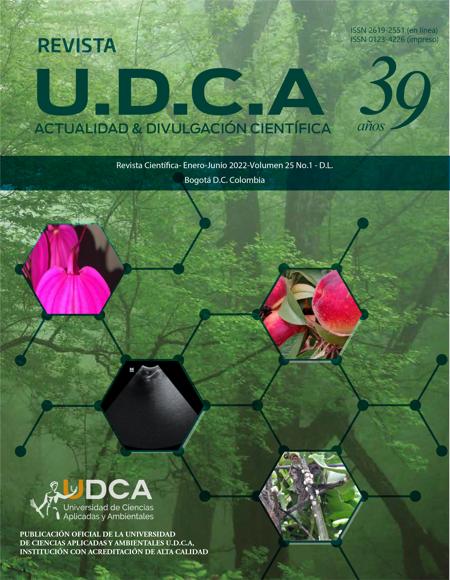Cambios fenológicos y fisicoquímicos durante el desarrollo del fruto en dos cultivares de duraznero en trópico alto
Phenological and physicochemical changes during fruit development in two peach cultivars in the high tropics
Contenido principal del artículo
Resumen
Se desconocen varios aspectos del desarrollo del fruto de duraznero en condiciones tropicales, información que permite realizar labores agronómicas con criterio técnico, por tanto, el objetivo fue determinar los diferentes cambios fisicoquímicos y fenológicos del fruto de durazno, en función del tiempo térmico, de las variedades ‘Dorado’ y ‘Rubidoux’, cultivados en zonas de trópico alto colombiano. Se seleccionaron al azar 51 árboles y 100 flores/planta, en estado de plena floración. Cada 15 días y hasta la cosecha, se hicieron mediciones de la firmeza, el índice de color de epidermis y pulpa, los sólidos solubles, la acidez titulable y la tasa respiratoria. De plena floración a cosecha, las variedades Dorado y Rubidoux tardaron 1081,8 GDC (153 días) y 1667,1 GDC (205 días), respectivamente. La firmeza presentó un incremento en los dos cultivares durante la fase 1 de desarrollo, luego disminuyó hasta la cosecha. El índice de color de epidermis y pulpa aumentó durante la maduración, con tonalidades amarillas, en las dos variedades. Los sólidos solubles incrementaron de forma continua y en los dos cultivares, con valores finales de 15,9 ± 0,9 y 15,5 ± 0,3 °Brix. La acidez mostró un incremento durante la fase 2 y luego disminuyó durante la maduración. La tasa respiratoria decreció entre la fase 1 y 3, con un incremento en la fase 2, relacionado con la lignificación del endocarpio, en los dos cultivares. Estos resultados contribuyen al entendimiento del desarrollo de los dos cultivares de durazno, bajo condiciones tropicales.
Palabras clave:
Descargas
Datos de publicación
Perfil evaluadores/as N/D
Declaraciones de autoría
- Sociedad académica
- Universidad de Ciencias Aplicadas UDCA
- Editorial
- Universidad de Ciencias Aplicadas y Ambientales U.D.C.A
Detalles del artículo
Referencias (VER)
AFRICANO-PÉREZ, K.L.; BALAGUERA-LÓPEZ, H.E.; ALMANZA-MERCHÁN, P.J.; CÁRDENAS-HERNÁNDEZ, J.F.; HERRERA-ARÉVALO, A. 2016. Caracterización poscosecha del fruto de durazno [Prunus persica (L.) Bastch] cv. Dorado producido bajo condiciones de trópico alto. Rev. Colombiana de Ciencias Hortícolas. 10(2):232-240.
https://doi.org/10.17584/rcch.2016v10i2.5212 DOI: https://doi.org/10.17584/rcch.2016v10i2.5212
BONGHI, C.; TRAINOTTI, L.; BOTTON, A.; TADIELLO, A.; RASORI, A.; ZILIOTTO, F.; ZAFFALON, V.; CASADORO, G.; RAMINA, A. 2011. A microarray approach to identify genes involved in seed-pericarp cross-talk and development in peach. BMC Plant Biology. 11:1-14.
https://doi.org/10.1186/1471-2229-11-107 DOI: https://doi.org/10.1186/1471-2229-11-107
BOUZAYEN, M.; LATCHE, A.; NATH, P.; PECH, J.C. 2010. Mechanism of Fruit Ripening M. In: Pua, E.; Davey, M. (Eds.). Plant Developmental Biology - Biotechnological Perspectives. Springer (Berlin, Heidelberg).
https://doi.org/10.1007/978-3-642-02301-9_16 DOI: https://doi.org/10.1007/978-3-642-02301-9_16
BROOKS, S.J.; MOORE, J.N.; MURPHY, J.B. 1993. Quantitative and qualitative changes in sugar content of peach genotypes [Prunus persica (L.) Batsch.]. J. the American Society for Horticultural Science. 118(1):97-100.
https://doi.org/10.21273/jashs.118.1.97 DOI: https://doi.org/10.21273/JASHS.118.1.97
CASTRO, Á.; PUENTES, G.A. 2012. Ciruelo y Duraznero (Prunus salicina Lindl.) - (Prunus persica (L.) Batsch.). In: Fischer, G. (Ed.). Manual para el cultivo de frutales en el trópico. Produmedios (Bogotá D.C.). p.370-392.
CEPEDA M., A.; VÉLEZ-SÁNCHEZ, J.; BALAGUERA-LOPEZ, H. 2021. Analysis of growth and physicochemical changes in apple cv. Anna in a high-altitude tropical climate. Rev. Colombiana De Ciencias Hortícolas. 15(2):e12508.
https://doi.org/10.17584/rcch.2021v15i2.12508 DOI: https://doi.org/10.17584/rcch.2021v15i2.12508
CHAAR, J.; ASTORGA, D. 2012. Determinación del requerimiento de frío y de calor en duraznero [Prunus persica (L.) Batsch.] mediante un modelo de correlación. RIA: Revista Investigaciones Agropecuarias. 38(3):289-298.
CIRILLI, M.; BASSI, D.; CIACCIULLI, A. 2016. Sugars in peach fruit: A breeding perspective. Horticulture Research. 3:1-12.
https://doi.org/10.1038/hortres.2015.67 DOI: https://doi.org/10.1038/hortres.2015.67
DARDICK, C.D.; CALLAHAN, A.M.; CHIOZZOTTO, R.; SCHAFFER, R.J.; PIAGNANI, M.C.; SCORZA, R. 2010. Stone formation in peach fruit exhibits spatial coordination of the lignin and flavonoid pathways and similarity to Arabidopsis dehiscence. BMC Biology. 8:13-30. https://doi.org/10.1186/1741-7007-8-13 DOI: https://doi.org/10.1186/1741-7007-8-13
DELA BRUNA, E. 2007. Curva de crescimento de frutos de pêssego em regiões subtropicais. Rev. Brasileira de Fruticultura. 29(3):685-689.
https://doi.org/10.1590/S0100-29452007000300050 DOI: https://doi.org/10.1590/S0100-29452007000300050
DESNOUES, E.; GIBON, Y.; BALDAZZI, V.; SIGNORET, V.; GÉNARD, M.; QUILOT-TURION, B. 2014. Profiling sugar metabolism during fruit development in a peach progeny with different fructose-to-glucose ratios. BMC Plant Biology. 14:336-339.
https://doi.org/10.1186/s12870-014-0336-x DOI: https://doi.org/10.1186/s12870-014-0336-x
ETIENNE, A.; GÉNARD, M.; LOBIT, P.; MBEGUIÉ-A-MBÉGUIÉ, D.; BUGAUD, C. 2013. What controls fleshy fruit acidity? A review of malate and citrate accumulation in fruit cells. J. Experimental Botany. 64(6):1451-1469.
https://doi.org/10.1093/jxb/ert035 DOI: https://doi.org/10.1093/jxb/ert035
FAMIANI, F.; BATTISTELLI, A.; MOSCATELLO, S.; CRUZ-CASTILLO, J.G.; WALKER, R.P. 2015. The organic acids that are accumulated in the flesh of fruits: occurrence, metabolism and factors affecting their contents – a review. Rev. Chapingo, Serie Horticultura. 21(2):97-128.
https://doi.org/10.5154/r.rchsh.2015.01.004 DOI: https://doi.org/10.5154/r.rchsh.2015.01.004
FAMIANI, F.; CASULLI, V.; BALDICCHI, A.; BATTISTELLI, A.; MOSCATELLO, S.; WALKER, R.P. 2012. Development and metabolism of the fruit and seed of the Japanese plum Ozark premier (Rosaceae). J. Plant Physiology. 169(6):551-560.
https://doi.org/10.1016/j.jplph.2011.11.020 DOI: https://doi.org/10.1016/j.jplph.2011.11.020
FISCHER, G.; CASIERRA-POSADA, F.; VILLAMIZAR, C. 2011. Producción forzada de duraznero (Prunus persica (L.) Batsch) en el altiplano tropical de Boyacá (Colombia). Rev. Colombiana de Ciencias Hortícolas. 4(1):19-32.
https://doi.org/10.17584/rcch.2010v4i1.1223 DOI: https://doi.org/10.17584/rcch.2010v4i1.1223
GALHO, A.S.; LOPES, N.F.; BACARIN, M.A.; LIMA, M. 2007. Chemical composition and growth respiration in Psidium cattleyanum sabine fruits during the development cycle. Rev. Brasileira de Fruticultura. 29(1):61-66.
https://doi.org/10.1590/s0100-29452007000100014 DOI: https://doi.org/10.1590/S0100-29452007000100014
HERNÁNDEZ, L.C.; HERNÁNDEZ, G.M.S. 2012. Crecimiento y desarrollo del fruto de copoazú (Theobroma grandiflorum [Willd. Ex Spreng.] Schum.) en la Amazonia occidental Colombiana. Agr. Col. 30(1):95-102.
LE DANTEC, L.; CARDINET, G.; BONET, J.; FOUCHÉ, M.; BOUDEHRI, K.; MONFORT, A.; POËSSEL, J.L.; MOING, A.; DIRLEWANGER, E. 2010. Development and mapping of peach candidate genes involved in fruit quality and their transferability and potential use in other Rosaceae species. Tree Genetics and Genomes. 6(6):995-1012.
https://doi.org/10.1007/s11295-010-0308-8 DOI: https://doi.org/10.1007/s11295-010-0308-8
LIU, Z.; MA, H.; JUNG, S.; MAIN, D.; GUO, L. 2020. Developmental mechanisms of fleshy fruit diversity in Rosaceae. Annual Review of Plant Biology. 71:547-573.
https://doi.org/10.1146/annurev-arplant-111119-021700 DOI: https://doi.org/10.1146/annurev-arplant-111119-021700
LO BIANCO, R.; RIEGER, M. 2002. Partitioning of sorbitol and sucrose catabolism within peach fruit. J. American Society for Horticultural Science. 127(1):115-121.
https://doi.org/10.21273/jashs.127.1.115 DOI: https://doi.org/10.21273/JASHS.127.1.115
MARIÑO-GONZÁLEZ, L.A.; BUITRAGO, C.M.; BALAGUERA-LOPEZ, H.E.; MARTÍNEZ-QUINTERO, E. 2019. Effect of 1-methylcyclopropene and ethylene on the physiology of peach fruits (Prunus persica L.) cv. Dorado during storage. Rev. Colombiana de Ciencias Hortícolas. 13(1):46-54.
https://doi.org/10.17584/rcch.2019v13i1.8543 DOI: https://doi.org/10.17584/rcch.2019v13i1.8543
MARTINEZ-GONZÁLEZ, M.; BALOIS-MORALES, R.; ALIA-TEJACAL, I.; CORTES-CRUZ, M.; PALOMINO-HERMOSILLO, Y.; LÓPEZ-GÚZMAN, G. 2017. Postharvest fruits: maturation and biochemical changes. Rev. Mexicana de Ciencias Agrícolas. 8(19):4075-4087.
https://doi.org/10.29312/remexca.v0i19.674 DOI: https://doi.org/10.29312/remexca.v0i19.674
MATTEOLI, S.; DIANI, M.; MASSAI, R.; CORSINI, G.; REMORINI, D. 2015. A spectroscopy-based approach for automated nondestructive maturity grading of peach fruits. IEEE Sensors J. 15(10):5455-5464.
https://doi.org/10.1109/JSEN.2015.2442337 DOI: https://doi.org/10.1109/JSEN.2015.2442337
MINISTERIO DE AGRICULTURA Y DESARROLLO RURAL, MADR. 2018. Estadísticas Agrícolas. Área, producción, rendimiento y participación municipal en el departamento por cultivo. Estadísticas Agrícolas. Disponible en internet desde:
http://www.agronet.gov.co/estadistica/Paginas/default.aspx (con acceso el 12/08/2020).
MIRANDA, D.; CARRANZA, C. 2013. Caracterización, clasificación y tipificación de los sistemas de producción de caducifolios: ciruelo, duraznero, manzano y peral en zonas productoras de Colombia. En: Miranda, D.; Fischer, G.; Carranza, C. (eds). Los frutales caducifolios en Colombia. Situación actual, sistemas de cultivo y plan de desarrollo. Equilibrio Gráfico Editorial Ltda (Bogotá D.C.). p.87-113.
PAYASI, A.; MISHRA, N.N.; CHAVES, A.L.S.; SINGH, R. 2009. Biochemistry of fruit softening: An overview. Physiology and Molecular Biology of Plants. 15(2):103-113.
https://doi.org/10.1007/s12298-009-0012-z DOI: https://doi.org/10.1007/s12298-009-0012-z
PINZÓN, E.H.; CRUZ-MORILLO, A.; FISCHER, G. 2014. Physiological aspects of peach (Prunus persica [L.] Batsch) in the high tropical zone: A review. Rev. U.D.C.A Act. & Div. Cient. 17(2):401-411.
https://doi.org/10.31910/rudca.v17.n2.2014.243 DOI: https://doi.org/10.31910/rudca.v17.n2.2014.243
PRASANNA, V.; YASHODA, H.M.; PRABHA, T.N.; THARANATHAN, R.N. 2003. Pectic polysaccharides during ripening of mango (Mangifera indica L). J. Science of Food and Agriculture. 83(11):1182-1186.
https://doi.org/10.1002/jsfa.1522 DOI: https://doi.org/10.1002/jsfa.1522
QUEVEDO, E.; CASIERRA-POSADA, F.; DARGHAN, A.E. 2018. Quality of peach fruits Jarillo cv. (Prunus persica L.) in Pamplona, Colombia. Rev. Brasileira de Fruticultura. 40(6):e-040.
https://doi.org/10.1590/0100-29452018040 DOI: https://doi.org/10.1590/0100-29452018040
RODRIGUEZ, C.E.; BUSTAMANTE, C.A.; BUDDE, C.O.; MÜLLER, G.L.; DRINCOVICH, M.F.; LARA, M.V. 2019. Peach fruit development: A comparative proteomic study between endocarp and mesocarp at very early stages underpins the main differential biochemical processes between these tissues. Frontiers in Plant Science. 10(715):1-19.
https://doi.org/10.3389/fpls.2019.00715 DOI: https://doi.org/10.3389/fpls.2019.00715
SILVA, D.F.; SILVA, J.O.; GONÇALVES, R.; RIBEIRO, M.; BRUCKNER, C. 2013. Curva de crescimento e padrão respiratório de frutos de genótipos de pessegueiro em região de clima subtropical. Rev. Brasileira de Fruticultura. 35(2):642-649.
https://doi.org/10.1590/S0100-29452013000200037 DOI: https://doi.org/10.1590/S0100-29452013000200037
SLAUGHTER, D.C.; CRISOSTO, C.H.; TIWARI, G. 2013. Nondestructive determination of flesh color in clingstone peaches. J. Food Engineering. 116(4):920-925.
https://doi.org/10.1016/j.jfoodeng.2013.01.007 DOI: https://doi.org/10.1016/j.jfoodeng.2013.01.007







